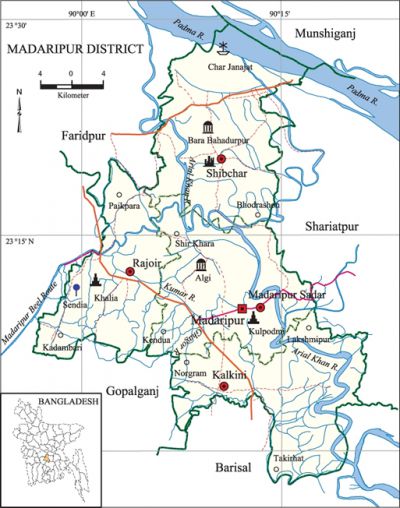Madaripur District
Madaripur District (dhaka division) area 1049.59 sq km, located in between 23°00' and 23°30' north latitudes and in between 89°56' and 90°21' east longitudes. It is bounded by faridpur and munshiganj districts on the north, barisal and gopalganj districts on the south, shariatpur district on the east, faridpur district on the west.
Population Total 1094458; male 538581, female 555877; Muslim 972126, Hindu 121418, Buddhist 36, Christian 852 and others 26.
Water bodies Main rivers: padma, arial khan, kumar, Ghagor; madaripur beel route Canal is notable.
Administration Madaripur Sub-Division was formed in 1854 under Bakerganj District and it was separated from Bakerganj District and included in Faridpur District in 1873. Madaripur Sub-Division was turned into a district in 1984. Of the four upazilas of the district shibchar upazila is the largest (321.88 sq km) and rajoir upazila is the smallest (229.28 sq km).
| District | |||||||||
| Area (sq km) | Upazila | Municipality | Union | Mouza | Village | Population | Density (per sq km) | Literacy rate (%) | |
| Urban | Rural | ||||||||
| 1049.59 | 4 | 3 | 54 | 416 | 1006 | 157810 | 936648 | 1043 | 48.0 |
| Others Information of District | ||||||||
|
Name of Upazila |
Area |
Municipality |
Union |
Mouza |
Village |
Population |
Density |
Literacy rate |
| Kalkini | 204.28 | 1 | 9 | 73 | 115 | 201764 | 988 | 46.3 |
| Madaripur Sadar | 283.14 | 1 | 15 | 147 | 185 | 345764 | 1221 | 51.1 |
| Rajoir | 229.27 | - | 11 | 95 | 187 | 228710 | 998 | 48.2 |
| Shibchar | 332.90 | 1 | 19 | 101 | 519 | 318220 | 956 | 43.5 |
Source Bangladesh Population Census 2011, Bangladesh Bureau of Statistics.

War of Liberation The Pak army killed Abdur Rashid Khan (Sub-Jailer of Madaripur Sadar upazila) along with his entire family on 24 April 1971. During 8 to 10 December a battle was fought between the freedom fighters and the Pak army near the Somaddar Bridge on the Madaripur-Takerhat Road in which a number of freedom fighters and Pakistani soldiers were killed and wounded. In this battle the Khalil Bahini captured 40 enemy soldiers including one Major and one Captain. During the war of liberation about 53 freedom fighters of Madaripur Sadar upazila were killed. The Pak army brutally killed about 50 persons at village Sendia of Rajoir upazila. They also conducted mass killing, rape and plundering and set many houses of Rajoir upazila on fire. Madaripur district was liberated on 10 December. There are mass graves at three places (Kalagachhia, Bahadurpur and Mithapur) of the district.
Literacy rate and educational institutions Average literacy 48.0%; male 50.1%, female 45.9%. Noted educational institutions: Government Nazimuddin College (1948), Government Barhamganj College (1964), Rajoir Degree College (1970), Shahebrampur Kabi Nazrul Islam College (1972), Kalkini Syed Abul Hossain College (1972), Shoshikar Shaheed Smriti College (1973), Charmuguria College (1978), Government Sufiya Mahila College (1984), Rijia Begum Mahila College (1985), Syed Abul Hossain College (1989), Uthrail High School, Charmuguria Merchants High School (1931), Donovan Government Girls' High School (1914), Mithapur LN High School (1915), Amgram High School (1917), Birmohan High School (1919), Panchchar High School (1920), 'Rajoir- Gopalganj Kapali Jubasangha High School (1929), RM High School (1930), Madbarer Char RM High School' (1930), Isibpur High School' (1932), Kadambari' High School' (1942), Shoshikar High School (1943), Kalkini Pilot' High School' (1946), Shahebrampur Multilateral High School' (1946), Munshi Kadirpur High School (1950), United Islamia Government High School (1950), Tekerhat High School (1952), Bhandari Kandi High School (1953), Tantibari Islamia High School (1954), Kanthalbari High School (1962), Aruakandhi Notakhola Barakhola High School (1963), Bahadurpur High School (1968), Gopalpur High School (1970), Khallia Rajaram Institution (1900), Shibchar Nandakumar Institution (1910), Dattapara TN Academy, Utrail High School, Madaripur Public Institution (1953), Rajkumar Edward Institution (1902), Rajoir KJSS Model Institution, Bhadrasan JC Academy (1918), DK Ideal Syed Atahar Ali Academy (1995), Charnachana Fazil Madrasa (1912).
Main sources of income Agriculture 61.33%, non-agricultural labourer 2.59%, industry 0.84%, commerce 15.46%, transport and communication 2.27%, service 7.25%, construction 1.71%, religious service 0.20%, rent and remittance 0.87% and others 7.48%.
Newspapers and periodicals Daily: Subarnagram (1998), Pranto (2001), Madaripur' News (2006), Bislashon (2009); weekly: Suprovat (1991), Shah Madar (1993), Shariatullah (1996). Ajkal (1999), Ganasachetanata (2006), Subarta' (2007); monthly: Jugachetona (1991), Poster (1991), Shanti Shamoyeki (1992), Jabol-e-Noor (2005); literary periodical: Shondipan, Kisholoy, Baishakhi, Canvas, Barnomala, Nabaprovat; defunct: Daily Diganta (1960), weekly janani Bangla (1972), Kisholoy (1984), weekly Madaripur Barta (1986), weekly Arial Khan (1989), fortnightly Balaronjika (1863).
Folk culture The most notable folk culture of the district include Gazir Gan, Kirtan, Dhuagan etc. Besides, Matua community of Rajoir upazila arranges Matua song during the Durga Puja festival.
Tourists spots Charmuguria Bandar, Hazrat Shah Madar Dargah, Auliapur Neelkuthi, Algi Kazibari Mosque and Shokuni' Lake (Madaripur Sadar Upazila); Raja Ram Mandir, Pronob Math, Annapurna Mandir, Khalia Shanti Kendra and Ganesh Pagol Mandir (Rajoir); Senapati Dighi (Kalkini); tomb of Haji Shariatullah and Raja Basu Durga Mandir (Shibchar). [Shahidul Haq]
See also The upazilas under this district.
References Bangladesh Population Census 2001 and 2011, Bangladesh Bureau of Statistics; Cultural survey report of Madaripur District 2007; Cultural survey report of Upazilas of Madaripur District 2007.
